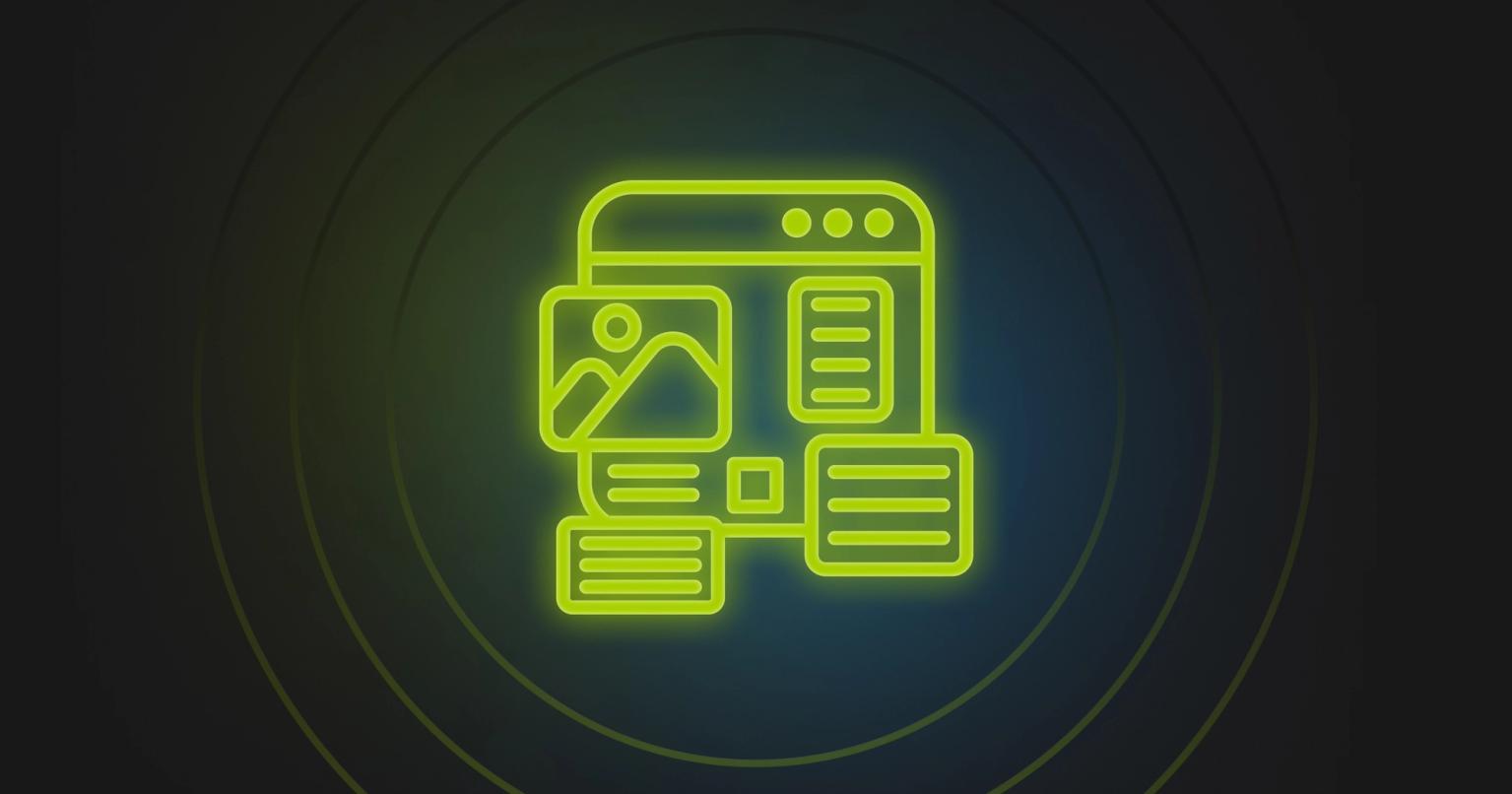Using Email Template Builders to Scale Personalization

Summary
Scale email personalization with no-code tools! Create on-brand, dynamic email campaigns that boost engagement and conversion rates.
What does dynamic content really mean for modern email marketing? How do you achieve personalization in your email campaign and do so at scale?
Personalization is one of the hottest topics in marketing, and for good reason. Emails with personalized subject lines are not only more likely to be opened, but they also have a 6x higher conversion rate on average. The power of personalization is undisputed.
Beyond the marketing hype lies a deeper question for demand generation and marketing operations teams: how do you achieve personalization at scale?
There is a revolution in email marketing driven by no-code email tools. They break down the traditional barriers of email creation—such as the need for technical knowledge or developing responsive emails that work across multiple platforms—and put the power of creativity back in the marketer’s hands. The promise of these tools and platforms like Knak is that they allow you to scale personalization across individual campaigns and your email templates as a whole.
Imagine having ready-made, on-brand email templates at your disposal, ready for personalization. The modular approach to email design with modern no-code platforms acts like a Lego kit, ready to assemble and allowing for the creation of a sophisticated email campaign.
In this post, we’ll dig into how using templates can level up your personalization strategy.
Benefits of Personalization in Email Campaigns
Using personalization techniques in your email campaigns can be highly effective. When done well (more on that later), you can expect benefits such as:
- Higher conversion rates
- Better open rates
- Increased click-through rates
- More sales leads
- Overall improved ROI on your email campaigns
These benefits are backed by research from top educational institutions like Stanford, which found that basic personalization tactics, such as adding a recipient’s first name to an email, increase the probability of the email being opened by 20%. Following this down the funnel, it increases sales leads by 31% and reduces unsubscribe rates by 17%. This leaves little doubt that personalization is essential in your email marketing strategy.
What Does Personalization Really Mean in Email Marketing?
In email marketing, personalization is the process of customizing content to the email recipient. Personalization can take many forms, from simple strategies like using the recipient’s first name in the subject line to more advanced methods, such as using machine learning and AI to provide dynamic offers. Personalization in email marketing is aimed at improving the user experience.
Personalization is somewhat of an umbrella term in marketing. What does it really mean? Is first-name personalization in the same category as setting up segmentations to enable dynamic content? In a sense, yes.
There is a personalization maturity model, where some types of personalization are quite simple and achievable, while others require a more sophisticated setup. For example, using the recipient’s first name in an email and including a human representative from your company in the email sender’s name (e.g., “Pierce from Knak” instead of just “Knak”).
Examples of Email Personalization
Personalization Strategy | Description |
|---|---|
Use the recipient's name in the subject line and email greeting | Add the recipient's first name in the subject line and email greeting to make it feel more personal. |
Send personalized offers on birthdays or anniversaries | Send special offers or discounts on significant dates like birthdays or anniversaries. |
Personalize the sender's name to make it more human | Use a human name (e.g., "John from Knak") as the email sender for a more personal touch. |
Use personalized subject lines based on recent interactions | Tailor the subject line to reflect the recipient's recent interactions or interests. |
Send personalized thank you emails after purchases | Send a personalized thank-you email to acknowledge purchases or specific interactions. |
Send abandoned cart emails with items left in the cart | Remind customers of items they left in their shopping cart, encouraging them to complete the purchase. |
Segment your audience and tailor content | Divide your audience into groups based on shared traits and send targeted emails to each group. |
Customize email content based on the recipient's location | Customize the email’s content to reflect the recipient’s location and relevant offerings. |
Send personalized re-engagement campaigns for inactive users | Send emails to inactive subscribers with personalized content aimed at re-engaging them. |
Create personalized product recommendations | Recommend products based on previous purchases or browsing activity. |
Use dynamic content based on demographics or preferences | Use dynamic content blocks that adjust based on recipient preferences or demographic data. |
Use behavioral triggers to send timely emails | Trigger personalized emails based on specific behaviors, such as a website visit or cart abandonment. |
Send milestone emails celebrating customer loyalty | Celebrate key milestones in the customer journey, such as anniversaries with the brand. |
Create personalized onboarding sequences for new customers | Create tailored onboarding sequences for new customers to guide them through their first steps. |
Customize email send times based on open history | Send emails at optimal times based on each recipient's historical open patterns. |
Create personalized event invitations based on interests | Invite recipients to events they may be interested in based on past attendance or expressed interests. |
Use personalized calls-to-action tailored to the journey | Customize the call-to-action based on the recipient's position in the sales funnel. |
Include personalized product usage data or statistics | Provide usage stats or insights, like product engagement metrics, to personalize the content further. |
Personalize email content based on industry or job title | Tailor the email content to the recipient's industry or job function for added relevance. |
Use personalized images or visuals based on preferences | Use personalized visuals and images that align with the recipient's preferences or previous behavior. |
Personalization Strategy | Use the recipient's name in the subject line and email greeting |
|---|---|
Description | Add the recipient's first name in the subject line and email greeting to make it feel more personal. |
Personalization Strategy | Send personalized offers on birthdays or anniversaries |
|---|---|
Description | Send special offers or discounts on significant dates like birthdays or anniversaries. |
Personalization Strategy | Personalize the sender's name to make it more human |
|---|---|
Description | Use a human name (e.g., "John from Knak") as the email sender for a more personal touch. |
Personalization Strategy | Use personalized subject lines based on recent interactions |
|---|---|
Description | Tailor the subject line to reflect the recipient's recent interactions or interests. |
Personalization Strategy | Send personalized thank you emails after purchases |
|---|---|
Description | Send a personalized thank-you email to acknowledge purchases or specific interactions. |
Personalization Strategy | Send abandoned cart emails with items left in the cart |
|---|---|
Description | Remind customers of items they left in their shopping cart, encouraging them to complete the purchase. |
Personalization Strategy | Segment your audience and tailor content |
|---|---|
Description | Divide your audience into groups based on shared traits and send targeted emails to each group. |
Personalization Strategy | Customize email content based on the recipient's location |
|---|---|
Description | Customize the email’s content to reflect the recipient’s location and relevant offerings. |
Personalization Strategy | Send personalized re-engagement campaigns for inactive users |
|---|---|
Description | Send emails to inactive subscribers with personalized content aimed at re-engaging them. |
Personalization Strategy | Create personalized product recommendations |
|---|---|
Description | Recommend products based on previous purchases or browsing activity. |
Personalization Strategy | Use dynamic content based on demographics or preferences |
|---|---|
Description | Use dynamic content blocks that adjust based on recipient preferences or demographic data. |
Personalization Strategy | Use behavioral triggers to send timely emails |
|---|---|
Description | Trigger personalized emails based on specific behaviors, such as a website visit or cart abandonment. |
Personalization Strategy | Send milestone emails celebrating customer loyalty |
|---|---|
Description | Celebrate key milestones in the customer journey, such as anniversaries with the brand. |
Personalization Strategy | Create personalized onboarding sequences for new customers |
|---|---|
Description | Create tailored onboarding sequences for new customers to guide them through their first steps. |
Personalization Strategy | Customize email send times based on open history |
|---|---|
Description | Send emails at optimal times based on each recipient's historical open patterns. |
Personalization Strategy | Create personalized event invitations based on interests |
|---|---|
Description | Invite recipients to events they may be interested in based on past attendance or expressed interests. |
Personalization Strategy | Use personalized calls-to-action tailored to the journey |
|---|---|
Description | Customize the call-to-action based on the recipient's position in the sales funnel. |
Personalization Strategy | Include personalized product usage data or statistics |
|---|---|
Description | Provide usage stats or insights, like product engagement metrics, to personalize the content further. |
Personalization Strategy | Personalize email content based on industry or job title |
|---|---|
Description | Tailor the email content to the recipient's industry or job function for added relevance. |
Personalization Strategy | Use personalized images or visuals based on preferences |
|---|---|
Description | Use personalized visuals and images that align with the recipient's preferences or previous behavior. |
Data and Content: Essential Ingredients for Personalization
Email personalization requires two important components: data and content. The data is a critical piece because it allows you to accurately segment and target users that fit a certain profile. If your underlying data is poor or inaccurate, you could make unforced errors, such as sending the wrong product recommendations or sending a birthday message on the wrong date.
The content component is just as important. Your data provides a roadmap of what options you have for personalization, but content is how you get there. Personalization can require a nuanced approach and may feel “creepy” when it goes too far. For instance, Mckinsey reports that 40% of US consumers found it unsettling that brands would send location tracking messages, causing apprehension and anxiety.
Marketers play a mission-critical role in personalization. They need to bridge the gap between data and content. How do you apply information about consumers to your personalization strategy? What's the right blend of tailoring messages to create a brand connection and being respectful of data privacy concerns? This is a nuanced approach that modern email marketers must consider in their personalization strategies.
Unlocking the potential of personalization is a key mandate for email marketers, but the approach requires a deft touch and a dash of subtlety. One of the most effective ways to personalize email communications without being overly presumptuous is to start with the email design and visuals.
Scaling Personalization with No-Code Email Tools
No-code email builders are breaking down the traditional barriers to email design by providing marketers with the ability to create HTML-perfect emails without needing to wade into the complex world of email development. No-code tools like Knak empower marketers to take email to the next level by baking personalization techniques directly into their templates. Here's how no-code tools help marketers scale personalization:
- Responsive email design
- Creative freedom
- Modular approach to personalization
- Visual and stylistic freedom
- Scaling across multiple campaigns
- Collaboration without bottlenecks
- Brand consistency
- Automation with personalization
- Democratizing segmentation and personalization strategies
Responsive email design
Responsive design is often overlooked as an element of personalization, but it’s a critical component that results in better email metrics and outcomes. According to Statista, more than 43% of emails are opened via mobile devices and this number is only expected to increase. Meeting your customers where they are is a key tenet of modern marketing, so when it comes to email marketing designing responsive emails is key.
The challenge facing email developers is twofold: 1) they need to design responsive emails that dynamically resize based on the screen size of the device, and 2) they need to account for hundreds of potential email clients on both desktop and mobile.
No-code tools like Knak take care of responsive design and the details required to render emails regardless of the email client. While no-code tools use drag-and-drop interfaces to help marketers create beautiful emails, behind the scenes, they compile the HTML and CSS required to render emails perfectly every time.
Creative freedom
The two components of personalization are data and content. With traditional email development methods, creativity is limited to what the designers and developers can achieve. While many developers are highly competent, it can still take weeks or even months to create a template suitable for customers.
No-code tools put the creation process directly in the hands of marketers. As you may notice, the creative process is often one of experimentation and trial-and-error. Designing emails can be really fun, and tweaking the design to make it match the concept in your head is part of the artform of marketing. Enabling this creativity while ensuring emails are coded correctly helps marketers apply personalization techniques in new and novel ways.
Modular approach to personalization
No-code tools act like Lego blocks—you can assemble individual modules and snap them together quickly using drag-and-drop functionality. When building email templates for Marketo, Pardot, or Salesforce Marketing Cloud in Knak, you can bake-in personalization content into each module. For example, having a standard introduction paragraph with first-name personalization or a module with adjustable imagery in your newsletter campaigns.
Visual and stylistic freedom
Like playing with Lego, some of the most interesting and engaging creations come through experimentation and trying out new ideas. With traditional template design practices, you're stuck in a never-ending cycle of sending concepts to designers, reviewing mockups, and making tweaks to adjust visuals and layout. No-code tools give you nearly unlimited freedom to explore and combine elements together. If it doesn't work, it's not a big deal nor does it require kicking off another costly cycle of revisions.
Scaling across multiple campaigns
One of the two pillars of personalization is a solid data foundation. Tools like Knak tie directly into your marketing automation platform to pull in data to create segmentations on the fly. These segmentations allow you to create dynamic content blocks, content modules that are rendered in real-time to display personalized content to email recipients.
This is a critical functionality for scaling personalization across multiple campaigns. Marketing automation platforms like Marketo have nearly unparalleled capabilities for slicing-and-dicing your customer database, but can represent a barrier to entry for email marketing professionals. By making key data points available in your email-building platform, it’s possible to quickly develop dynamic content that displays personalized content.
Collaboration without bottlenecks
Iterating quickly on designs allows for marketing teams to bring more ideas to fruition without leaving good ideas on the cutting room floor in favor of expediency. Real-time approval workflows keep everyone on the same page and give stakeholders the opportunity to weigh in, add feedback, and have that feedback acted on with minimal delay. The indirect benefits of collaboration allow for scaling personalization beyond the basics and to try more complex techniques without the need for lengthy approval processes.
Brand consistency
Experimentation can't come at the expense of consistent branding. No-code email tools allow for the definition of brand rules to ensure all emails adhere to a standard set of guidelines. These brand guardrails are a critical component of the creative process, encouraging your team to try new things within the safety of clear brand guidelines.
No-Code Tools and the Future of Email Personalization
The ability to personalize email marketing at scale is no longer a distant dream—it’s the new standard. From minor tweaks to emails, like first-name personalization, to integrating advanced segmentations to render content dynamically, personalization is a core part of modern email marketing. The dual pillars of data and content allow marketers to accurately identify discrete segments and create customized content that speaks to their audience.
The rise of no-code tools like Knak is democratizing the email design process and playing a key role in scaling personalization practices. Not only is it possible to use data and functionality from marketing automation platforms like Marketo, it's easy for marketers to take control of the design process. This is a key point: having creative control over email content allows marketers to craft more powerful messages.
Tools like Knak have broken down traditional barriers to email design—greatly reducing or even eliminating the need for help from development teams and saving teams from engaging with agencies to do the design work for them. Features like brand guardrails and approval workflows ensure consistent email design while unlocking creativity and, dare we say, the fun of creating beautiful emails.












